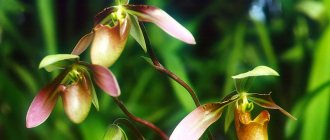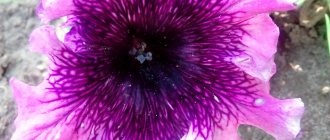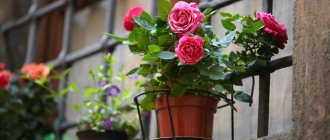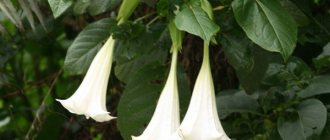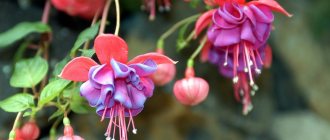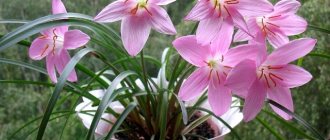Externally, mini-orchids seem too small and fragile. Sometimes even experienced orchid growers are in no hurry to take on the responsibility of caring for such “delicate” plants. But is it as difficult to grow miniature orchids as it seems at first glance?
In recent years, you can find a large number of miniature orchids at flower shows. With their very modest size (up to 20-25 cm), they have remarkable decorative potential. Fragile and elegant, they will become a real decoration for any collection.
At first, you may get the impression that caring for these delicate creatures is much more difficult than caring for “standard-sized” orchids. In fact, there are no fundamental differences in the rules of care between them. However, first things first.
- Mini, midi, standard and other varieties of phalaenopsis (+ the best varieties and hybrids)
Did you know that phalaenopsis plants can differ not only in the color of their buds?
Mini-orchids of the genus Amesiella and Ancistrochilus
Amesiella Garay – Amesiella
The genus is named after the American botanist Ox Ames, who described many tropical orchids from Southeast Asia and tropical America. There are 3 miniature epiphytic species in the genus.
Amesiella philippinensis (Ames) Garay
Homeland - Philippine Islands. It grows as an epiphyte in tropical rain forests at altitudes up to 800 m above sea level. m. Monopodial epiphyte or lithophyte with a short shoot and rather large (5 cm in diameter) snow-white flowers, the most expressive part of which are long (3.5 cm) spurs filled with nectar. The lip has a yellow spot in the center. Branches usually appear in winter on fleshy, drooping flower stalks. Flowering continues until the first spring months.
Such a mini-orchid at home requires a moderately warm growing temperature (day - 18-30 ° C, night 13-26 ° C), strong diffused light (autumn-winter supplementary lighting is required) and average air humidity (50-70% ). In winter, watering is slightly reduced.
Block culture is preferred, but can also be kept in small pots with good drainage, breathable substrate, and with regular spraying.
Ancistrochilus Rolfe – Ancistrochidus
The name of the genus Ancistrochilus comes from two Greek words for “fishhook” and “lip” and reflects the structural features of the anterior blade of the lip with a thin, curved tip. The genus includes two species of small epiphytic orchids from the tropical rainforests of Africa (from Guinea to the Central African Republic, Equatorial Guinea, Congo, Uganda and Tanzania). They grow as epiphytes or butt epiphytes in lowland and montane tropical rainforests, as well as on coasts.
Ancistrochilus rothschildianus O'Brien
A sympodially growing epiphyte from tropical rain forests of Africa (from Guinea to Tanzania). Pseudobulbs are flattened, 2-3-leafed. The inflorescences are lateral, 6-8 cm long, the flowers are quite large compared to the shoots, 7 cm in diameter, bright crimson, fragrant.
Look at the photo - this mini-orchid has a purple three-lobed lip that is strongly bent back:
The flowers have a not very pleasant smell with a metallic tint. One of the few brightly colored compact African orchids. Blooms in summer, autumn and early winter. The plant is a moderately warm plant with a cool, dry winter, during which not only its leaves, but also its roots die.
At this time, the plants need to stop watering and need additional lighting (optimal illumination 10,000-20,000 lux). For abundant flowering, it requires clear differences in day and night temperatures. The relative air humidity should remain high at all times. Block culture is preferred.
Landing
Priming
- soil for planting in a specialized store. Experienced flower growers prepare their own;
- Sold in transparent containers with sphagnum moss;
- Tree bark forms the basis of the soil. For mini orchids they should be small - about one centimeter;
- You soak them in water for several days. And dry;
- You can also make a mixture of pine bark and dry moss. Add a few small pieces of charcoal. If the humidity in the room is insufficient.
It is better to buy soil for orchids in a store.
Optimal capacity
- The container must be transparent. And mini orchids do not need their larger sizes;
- Where to get? In a specialized store, just tell them that you need a mini phalenpsis container. The offer will be mandatory;
- There is also a universal transparent plastic bottle. They left the soda after. But only with numerous holes for good ventilation.
Peculiarities
- Repot orchids on a bed of moss once a year;
- And do it in the spring. It is at this time that a new leaf appears from its growth point. And also necessarily before the formation of the peduncle;
- Use small pieces of bark (if replanting in bark soil);
- She doesn't need large pots;
- When replanting, to remove old soil or moss, it is enough to immerse it in water for a few minutes.
Flowers of mini-orchids of the genus Ascocentrum
Ascocentrum Schltr - Ascocentrum.
A small genus of monopodially growing epiphytic or lithophytic orchids, numbering only 4-5 species. The name of the genus is made up of two Greek words - "askos" - bag and "kentron" - spur and describes the most remarkable feature of the flower - a short spur at the base of the lip.
Medium-sized orchids with short, hard, leathery leaves and thick aerial roots. The inflorescence (an erect or slightly curved multi-flowered dense raceme) bears several dozen wide-open, medium-sized flowers with a small spur.
The sepals and petals are similar, the three-lobed lip is motionlessly connected by its base and lateral lobes to the base of the column, and there is a callus-like outgrowth inside the lip.
Plants need warm or moderately warm growing conditions, strong diffused light, and high relative humidity (70-80%). During the winter holidays, the temperature may drop slightly, but not below 15 °C. During active growth, regular, abundant moisture is required, but during the dormant period, watering should be limited to avoid rotting of the base of the shoot.
Can be kept in pots, hanging baskets, or in potted blocks. During active growth, it requires abundant watering, strong diffused illumination (20,000-35,000 lux) and intensive fertilizing with complete mineral or organic fertilizers.
Ascocentrum ampullaceum - Vein-like Ascocentrum.
Homeland - tropical regions of the Himalayas, Burma and Thailand. Epiphyte, rises to low altitudes up to 300-900 m above sea level. Monopodially growing epiphytic orchid with fleshy, dense leaves 14 cm long, densely covered with purple dots. The roots are thick.
The inflorescences are dense, multi-flowered, short (up to 8 cm long), bearing many compactly arranged, pink-purple flowers with a diameter of 1.8-2.5 cm, sparkling in the sun. The petals and sepals of the flowers of this mini-orchid are almost the same shape, 0. 9 cm. The lip is small, brighter colored, 0.6-0.7 cm long. The spur is short, 0.7 cm long.
The column is short, round in cross-section. Blooms in February-July.
Ascocentrum miniatum - Rust-red Ascocentrum.
The species is quite widespread in South and Southeast Asia, from the Indian Himalayas to Indochina and the Indonesian Islands. Monopodially growing epiphyte, grows on the trunks of large trees. A small orchid with a relatively short, erect, strong stem, sometimes branching closer to the base.
The leaves are green, fleshy, grooved, toothed at the end, 5-28 cm long. The inflorescences of this dwarf orchid are formed in the axils of the lower leaves, they reach 24 cm in length and develop many small orange-red or yellow-orange flowers with a diameter of 1.0- 1.8 cm.
Petals and sepals are similar, elliptic-obovate, obtuse. The lip is small, pointed at the end, 0.4 cm long. The spur is straight, cylindrical, 0.7-0.9 cm long.
The flowering time of this species in nature is spring - early summer. In cultivated conditions, flowering plants can be found almost all year round, but the peak of flowering occurs in April, May and June.
Emerging problems
Even a very attentive and careful gardener can sometimes encounter certain problems when growing dwarf orchids. It is important to know the causes of unwanted situations and how to eliminate them.
Yellowing of leaves
There are several reasons for yellowing leaves:
- natural aging - one leaf has turned yellow, and the rest remain unchanged - do not panic;
- problems with watering - if there is not enough, the leaves begin to dry out, if there is too much, the roots rot and this is reflected in the foliage - correct the watering schedule;
- lighting - strong sunlight causes burns, with a lack of light the leaves become lethargic and dry - place the plant in comfortable conditions;
- improper nutrition - a lack of elements leads to yellowness, an excess causes a chemical burn - do not violate the feeding schedule.
Dropping buds
If a plant that is preparing to flower suddenly drops its buds, this signals some kind of stressful situation for it. The reason may be any violation of the conditions of containment:
- low lighting;
- sudden change in temperature in any direction;
- location near an open window where drafts are possible;
- broken watering regime.
Orchids drop their buds due to errors in care.
To preserve the buds, care is required in caring for the dwarf orchid: it should be protected from drafts, cooling and overheating, not flooded, and additional lighting should be provided in winter.
INTERESTING! Orchids should not be placed close to bouquets of flowers and fruits, as they emit ethylene, which causes the buds to fall off.
Wrinkling or rotting of leaf blades
The cause of rotting leaves is most often improper watering : with an excess of moisture, the roots are affected by putrefactive fungi, which gradually penetrate into the leaves. Root disease and leaf loss can be prevented by simple prevention:
- do not violate watering schedules;
- be sure to ventilate the room - fresh air can easily deal with any rot;
- provide additional lighting - light kills rot;
- do not overfeed the orchid - after chemical burns of the roots, they are susceptible to damage;
- Inspect the plants regularly - this way you can notice the problem earlier.
Consequences of a lack of sunlight
Sunlight is the source of life and health for tropical dwarfs; even shade-loving orchids react negatively to its lack. When located in the shade, exotics have problems that are easier to prevent than to fix:
- long-term refusal to flower;
- discharging already formed buds and blossoming flowers;
- change in leaf color - significant darkening relative to the leaves of a healthy orchid;
- stunting of growth - with a long period of lack of light.
Drafts
All orchids, including dwarf ones, are very afraid of significant movements of air masses in their environment, since drafts lead to hypothermia of leaves and roots. The result of this can be the dropping of buds, failure to flower and general inhibition of the plant, including growth arrest. Therefore, an important concern of flower growers is to protect their exotic beauties from unnecessary wind blows.
Orchids have an extremely negative attitude towards drafts.
Reaction to excess nitrogen
Orchids that receive an excessive dose of nitrogen fertilizers when feeding can produce a rapid and strong increase in green mass. The plant's strength will be spent; it will not be enough to prepare for the formation of buds. The result of this will be a refusal to flower for a long time. Unexpected growth will also lead to cracking of the protective tissues, and the orchid can easily be affected by diseases and sucking pests.
Dwarf orchids of the genus Bulbophyllum
Bulbophyllum Thou. - Bulbophyllum.
The generic name is composed of two Latin words - “bi” - two and “frenum” - bridle and reflects the structural feature of the stamens - 4 authentic ones are located separately on two stalks.
The genus consists of 26 epiphytic or lithophytic species from South America. Small to medium-sized orchids with tetrahedral olive-green single-leaved pseudobulbs and few-flowered short inflorescences.
Bifrenaria atropurpurea - Bifrenaria dark purple.
As you can see in the photo, this mini-orchid would be very appropriately called “black orchid”:
This striking plant with dark flowers is found on tree trunks only in the lowland forests of Brazil. A small sympodially growing orchid with tetrahedral cross-section, unifoliate pseudobulbs 6 cm long. As they age, the pseudobulbs become very wrinkled. The inflorescences appear at the base of the pseudobulbs from rather densely packed brown scales and bear 3-5 dark-colored flowers.
Fully opened flowers reach 4 cm in diameter, their petals and sepals are purple-brown, slightly lighter in the middle part. The lateral sepals are fused at their bases under the lip and spread horizontally.
The petals are smaller and directed forward. The lip is round, concave, bright pink and white, slightly wavy at the end. The column is short, wine-red, the anther calyx is white. The flowers of this species have a very pleasant aroma. Blooms in March-June.
When cared for at home, these dwarf orchids require a moderately warm growing regime with a winter night temperature of 14-18 ° C, high air humidity (70-80%) and strong diffused light. This species grows well on western windows, where it suffers less from direct sunlight.
Bulbophyllum - Bulbophyllum.
A large genus of more than 1,800 epiphytic, lithophytic or rarely terrestrial species, widely distributed in tropical and subtropical regions of Africa, Asia, Australia, New Guinea and the islands of the Indian and Pacific Oceans. Perennial symnodially growing rhizomatous herbaceous plants (often with thickened pseudobulbs).
Leaves from 1 to several. Inflorescences are single- to multi-flowered, racemose or umbellate. Flowers are of different sizes (from 0.5 mm to 50 cm), of various colors, sometimes with numerous projections not only on the lip, but also on the tepals of the outer perianth circle; the lip of the flowers is often movably articulated with the stalk of the column and in the middle part is curved back.
The wide range of the genus suggests that among the bulbophyllums there are both heat-loving and cold-loving species. All of the species listed below are well suited for indoor greenhouses; they require a moderately warm growing regime, moderate diffused light and constantly high air humidity.
Bulbophyllum disciflorum Rolfe
In culture, the species is also known as Trias disciflora (Rolfe) Rolfe. A small epiphytic orchid native to Thailand, Laos and Vietnam (up to 1500 m above sea level). The pseudobulbs are ovoid and very small (about 1.5 cm), collected in close clones, unifoliate.
The leaves are bright green, with pointed tips, fleshy, up to 6 cm long. Short inflorescences develop at the base of the pseudobulbs and bear a single greenish flower, 2.5 cm in diameter, which is densely dotted with red-purple dots on the inside. The lip has an even brighter purple color.
Flowering occurs in February-March.
Requires a moderately warm growing regime, moderate diffused light with mandatory shading from direct sunlight and high air humidity (80-85%).
Bulbophyllum frostii Summer. — Bulbophyllum frosta.
Homeland - evergreen low-mountain forests of Malaysia, Thailand and Vietnam (1450 m above sea level). Epiphyte or lithophyte of medium size. Long rhizomatous shoots with flattened single-leaved pseudobulbs.
The leaves are fleshy, oval, bluish-green. Inflorescences are few-flowered, short, umbrella-shaped, with well-defined bracts. The flowers are olive green, with dense dark purple spots and numerous warts. The lip is purple, bent backward, with a longitudinal central groove.
Blooms from December to April. Prefers block cultivation.
Bulbophyllum lobbii Lindl. — Bulbophyllum Lobba.
Homeland - low-mountain forests of Southeast Asia and Indochina (1300-1800 m above sea level). Long rhizomatous shoots with single-leaved ovoid pseudobulbs and petiolate leathery leaves. Inflorescences are single-flowered, erect.
The flowers are about 7.5 cm in diameter, light yellow with purple-brown stripes on the petals and spots on the sepals. The narrow, heart-shaped, pointed lip is movably articulated, and at the point of articulation there is a bright yellow convex callus.
Blooms from May to July.
Can grow well both in pots and on blocks, requires a moderately warm growing regime, and needs moderate light.
Bulbophyllum nipondhii Seidenf. — Bulbophyllum Nipponda.
Homeland - mid-mountain forests of Thailand, Vietnam and southern China (up to 1500 m above sea level). Epiphyte of small or medium size. Long rhizomatous shoots with single-leaved ovoid pseudobulbs and petiolate leathery leaves. Inflorescences are few-flowered, umbrella-shaped.
The flowers are 2 cm long, bright crimson, with purple veins on the sepals, which are connected along their entire length by their upper edges.
Usually blooms in April and May.
"Epiphytic trees"
In addition to blocks, these “epiphytic trees” look very impressive.
To create them, driftwood or sections of trunks of interesting, curved shapes are used. Plants are also tied to them with fishing line, just like to blocks.
Plant roots can be wrapped in a small amount of sphagnum (but without fanaticism) to protect them from drying out. But many experienced orchid growers advise growing without moss (this also applies to blocks), because it is often the culprit of prolonged waterlogging of the roots, which is why they begin to rot. In general, it's up to you.
The driftwood can be placed directly on the windowsill by placing it on a tray with wet pebbles. If the “epiphytic tree” is supposed to be kept behind glass (orchidarium, florarium), then the roots do not have to be covered with moss, since in “glass” conditions the humidity is already high.
On such “trees” they grow mainly tiny, dwarf orchids or very young plants, for example, children of also miniature species, but larger in size than dwarf ones.
How to create miniature gardens with your own hands
Although, it all depends on the size of the snag itself. If you take a larger piece of driftwood, then it is quite possible to attach on it medium-sized plants by miniature standards with short peduncles and leaves no more than 10-15 cm, for example, Promenea or Sophronitis.
Miniature cattleya and cochleanthes orchids
More recently, these cattleyas were part of the genus Sophronitis Lindl. They are common in the montane forests of Brazil, and require a cooler growing regime than most members of the Cattleya genus.
Cattleya cernua (Lindl.) Van den Berg - Cattleya oblique.
In culture, the species is also known as Sophronitis setia (Lindl.) Lindl. An epiphyte or lithophyte of small size from the low-mountain rain forests of Brazil (1000-1500 m above sea level). Psedobulbs are oval or cylindrical, unifoliate. Inflorescences are apical, 4-10-flowered.
The flowers are 2.2-2.7 cm in diameter, cinnabar-red, the lip at the base is orange-yellow with purple spots. Blooms in autumn or winter.
Requires moderate or cold growing conditions, strong indirect light and high air humidity (>80%). Daily temperature fluctuations should be 7-9 °C.
Prefers block cultivation.
Cattleya coccinea Lindl. — Cattleya scarlet.
In culture, the species is also known as Sophronitis alai (Sophrontis coccinea (Lindl.) Rchb.f.) An aegsphytic or lithophytic plant from Brazil, grows in lowland or low-mountain rain forests (650-1670 m above sea level) on moss-covered trees or on mossy stones. Pseudobulbs are fusiform, unifoliate, only 2-5 cm long.
Inflorescences are apical, 1-2-flowered. The flowers are 3 cm in diameter, scarlet, the base of the lip is orange-yellow with scarlet longitudinal stripes.
Mass flowering occurs in January, February, March and April.
Cochleanthes Raf. - Cochleanthes.
The genus consists of 40 species from the humid cloud forests of South America.
Sympodially growing epiphytes of medium size with small thickened pseudobulbs, two apical leaves and fan-shaped pointed green vaginal leaves on the rhizomes. Inflorescences are lateral, single-flowered.
Requires a cold growing temperature (summer - 27 ° C, winter - 8 ° C), strong diffused light and high air humidity (80%).
Cochleanthes flabelliformis
A small, delicate orchid from the shady, moist mountain forests of Venezuela, Colombia, Honduras, Nicaragua, Brazil and the islands. Jamaica (250-1200 m above sea level). Pseudobulbs are not pronounced; the leaves on each shoot form a kind of fan.
Inflorescences are 10 cm long, lateral, erect, single-flowered. The flowers are fragrant, 7.5 cm in diameter, white with a wide striped purple-violet lip. Blooms in March-June.
Plant of warm or moderate growing conditions. Grows well in conditions of constantly high air humidity, diffused light and with mandatory shading from direct sunlight.
Are there sub-varieties?
This hybrid is widely used in home floriculture; subcultivars of this variety can be found in botanical gardens and greenhouses. The most common varieties can be considered: Mini Mark “Island”, “Holm”.
Miniature flowers do not have a pronounced aroma. Mini Mark “Maria Teresa” has an exquisite floral light aroma. The flower is especially fragrant when exposed to sunlight. Mini Mark with peloric flowers are distinguished by the decorative irregularity of the petals themselves. A peculiarity is that the buds are yellow at the beginning of ripening, then become white.
Mini orchids epidendrum and helcia
Epidendrum peperomia - Epidendrum pereromia.
Grows in pine forests and oak forests of Colombia and Venezuela (600-2700 m above sea level).
A miniature epiphyte with thin branching, laterally compressed shoots forming thick cushions, double-rowed leaves ciliated at the edges and greenish-purple flowers with a glossy brown-purple obovate lip. The flowers are 2.5 cm in diameter, fragrant, waxy.
Blooms from February to May.
Requires moderate growing temperatures, strong lighting and constantly high air humidity (70-85%). Prefers block cultivation.
Epidendrum schlechterianum Ames - Schlechter's Epidendrum.
An extremely widespread small orchid, it is found along the Pacific coast of Mexico to Brazil and Peru, as well as on the islands of Trinidad and Jamaica. It grows as an epiphyte and lithophyte in a wide range of habitats from tropical rain forests to dry highlands, rising into the mountains to heights of up to 1100 m above sea level. m.
This species is located on a vertical substrate “upside down”; its not very long (10-15 cm) branching thin shoots from top to base are covered with fleshy succulent leaves 1-3 cm long, 0.3-0.4 cm wide.
The leaves have a purple midrib, a pointed bilobed tip and a keel on the outside. In spring, near the top of the shoots, from 1 to 3 flowers appear on short peduncles, so unusual that they are difficult to immediately notice among the leaves.
Most of all, the flowers resemble strange greenish-purple insects. The flowers, like the shoots, seem to be spread out on the substrate, they reach 2.5 cm in length and can be colored yellowish-green, greenish-bronze, reddish-green, purple or pink.
The flower segments are translucent and pointed. The wide lip is connected to the column up to half its length. Blooms in spring and summer.
Requires moderate growing temperatures, strong lighting and constantly high air humidity (70-85%). Prefers block cultivation.
Helcia Lindl. – helcia
A small genus of sympodially growing epiphytic orchids from tropical areas of America, including only 4 species. It is characterized by single-leaved, thickened pseudobulbs, drooping inflorescences with single flowers with a three-lobed lip.
Helcia sanguinolenta Lindl. — Helcia blood-spotted.
The homeland of this epiphytic orchid is Ecuador and Colombia (600-3000 m above sea level). Pseudobulbs 8 cm long, unifoliate. The leaves are up to 20 cm long, strongly tapering towards the base. The inflorescence appears at the base of the pseudobulb and develops a single flower with olive green petals and sepals covered with chestnut brown spots and a white lip streaked with carmine red veins.
The lip is long, bifurcated at the end, where its lobes diverge slightly to the sides, with jagged and curled edges, with two erect yellow shell-like appendages at the base near the column, between which there are two outgrowths.
The callus of the lip is yellow, and its anterior lobe is white, with red-purple spots and stripes that do not reach the tip of the lip.
It can bloom in May or late autumn and winter - from October to February. Requires a moderate growing regime (temperature in summer 18-26 °C, winter - 12-20 °C), moderate illumination (10,000 - 20,000 lux) and high relative humidity throughout the year.
Reproduction
How often do they give babies?
- Babies appear on flower stalks. Healthy plants also produce good children;
- A leaf grows from a bud. And a little later, aerial roots;
- Only with their presence children are sent away.
Important! They do not appear so willingly or often. You can stimulate their appearance by cutting off the peduncle. And apply cytokine paste to the scaled kidney.
Baby phalaenopsis on a peduncle.
Methods
It is known that the vegetative method: seeds, division, apical cuttings.
You can propagate phalaenopsis yourself:
- And they do this by separating new side shoots. If they have grown to 5-6 centimeters. They are called children;
- Can be transplanted directly into prepared containers (pots). Cut plastic bottles are often used. With numerous holes;
- You can place them in special greenhouses with wet sphagnum moss. If they exist.
Remember! It is necessary to cut with a disinfected instrument (knife, scalpel, scissors).
Transplant from moss - carry out for phalaenopsis purchased in stores:
- You can implement it immediately;
- Or you can wait. Until it blooms;
- At the same time, ensure proper care.
Types of dwarf orchids of the genera Isabelia and Lelia
Isabelia Barb.Rodr. - Isabelia.
A small genus from Brazil, Paraguay and Argentina, including 3 species. These are miniature sympodially growing epiphytes or lithophytes with oval 1-2-leaf pseudobulbs, thin branching rhizomes and few-flowered apical 1-4-flowered inflorescences.
Isabella violacea - Purple Isabelia.
Also known as violet sophronitella (Sophronitella violacea (Lindl.) Schltr.). Endemic to Brazil, it grows as an epiphyte or lithophyte in moist montane forests at moderate altitudes. Pseudobulbs are ovoid, 2-3 cm long, 1-2-leafed.
The leaves are linear, v-shaped when cut. Inflorescences are apical, 5 cm long, shorter than the leaves, 1-4-flowered. The flowers are 2.5 cm in diameter, lavender-pink, evenly colored, wide open, with pointed petals and sepals. Blooms in late autumn and winter.
When cared for at home, this dwarf orchid needs a moderate growing temperature, bright diffused light (10,000-15,000 lux) and moderate air humidity (50-70%). It does not have a clearly defined dormant period, so it needs regular watering throughout the year. Prefers block cultivation or growing in small clay pots with a light, well-drained substrate.
Laelia Lindl. - Lelia.
The once fairly large Rodlelia has now been reduced to 25 species, transferring a significant portion to the genus Cattleya. The homeland of lilies is the tropics of Central and South America. These are sympodially growing epiphytic, lithophytic or terrestrial orchids with thickened 1- or multi-metameric pseudobulbs, 1-3 fleshy apical leaves and erect few- or multi-flowered inflorescences. The flowers are large or small, often brightly colored.
Laelia speciosa - Beautiful Laelia.
A miniature epiphytic orchid native to the mountainous regions of Mexico (1400-2500 m above sea level). Pseudobulbs up to 6 cm long, oval, 1-2-leafed. The inflorescence is apical, 1-2-flowered. The flowers are 12-18 cm in diameter, lilac-pink.
Look at the photo - this dwarf orchid has a lip that is wavy along the edge, with a longitudinal stripe, pale yellow inside the throat of the lip, white with purple spots in the middle and with a wide pink-purple edge:
Typically blooms from March to August, with peak flowering in March and June. Sometimes autumn flowering is observed (October).
Requires cold or moderately warm conditions (with a winter night temperature of 12-16 ° C), moderate diffuse illumination and high relative humidity (80%).
Flowering stimulates a winter dormant period, during which the temperature is lowered to 10-12 ° C and watering is reduced as much as possible. Well suited for cultivation on a block with completely exposed roots.
Block growing
To create blocks, thick pieces of pine or larch bark and small pieces of wood are used. They can be found in the forest (bark removed from fallen trees), or at woodworking factories, as well as in stores selling orchids.
The plant is first carefully secured to the block with fishing line, nylon thread or thin wire. When it grows to the block, the fishing line is removed.
Block orchids are usually grown in glass orchidariums with artificial lighting. Or they build entire “flower windows” - a florarium is attached to an ordinary window in the house. Or simply attach a metal mesh with large cells to a window (possibly opposite a balcony window), onto which the finished blocks are hung using hooks.
Miniature orchids of the genera Promenea and Psychopsiella
Promenaea Lindl. - Promenea.
A genus of epiphytic or lithophytic orchids from Brazil, including 19 species. Representatives of the genus live in humid low-mountain tropical forests, growing on rocky slopes and butt parts of trees. All promeneas are small sympodially growing orchids with convex pseudobulbs hidden in the bases of leaf sheaths and with single flowers up to 5 cm in diameter.
The best known in culture are the golden-yellow promenea (P. xanthina (Lindl.) Lindl.) and the stapelioides promenea (P. stapelioides (Link & Otto) Lindl.). All species of the genus require moderately warm keeping (winter night temperature 14-16 °C), moderate diffuse illumination and high relative air humidity (80%).
Preferably kept in small mesh pots or baskets.
Psychopsiella limminghei - Limming's Psychopsiella.
The only species of this monotypic genus lives in the tropical rainforests of Brazil and Venezuela. A miniature epiphytic orchid with small flattened pseudobulbs up to 2 cm long and rather large flowers compared to the plant itself (3-4 cm in diameter).
Petals and sepals, blunt at the ends, are brownish-orange or red, with light spots. The dorsal sepal is concave. The petals are reddish-brown with a yellow border around the edges. The lateral lobes of the bright yellow lip are also covered with numerous bright reddish-brown stripes and spots; they are narrow at the base and widen into vertical ears.
The anterior lobe of the lip has a narrow isthmus and can be directed upward or slightly curved. The column has comb-like wings. Maximum flowering occurs in the summer months - from May to September, but individual flowering plants can be found in late autumn and early spring.
Requires moderate warmth or moderate growing conditions, diffused illumination (18,000-25,000 lux) and high air humidity (75-80%). It does not tolerate stagnant water near the roots, so in winter watering is slightly reduced. Prefers block culture and regular spraying.
Transfer
Necessity
Dwarf orchids do not tolerate the transplantation process extremely well , so experts recommend doing this only if absolutely necessary. A signal for a mandatory transplant can be:
- depressed, unhealthy appearance of the orchid;
- compacted soil, which is very noticeable upon inspection;
- gray and brown roots sticking out of the pot;
- the smell of mold or autumn leaves.
These signs indicate that the orchid has grown out of its container, and the substrate should be changed due to its expiration date.
ADVICE! Orchids that are gaining color or blooming should not be exposed to the dangers of transplantation.
Selection of substrate and container
For dwarf orchids living in the ground, it is best to use a ready-made substrate from flower shops.
Take a container only slightly larger than the old pot - otherwise the plant will grow and forget about flowering.
For orchids with green roots that participate in photosynthesis, a clear plastic pot is ideal. Specimens growing without soil can be mounted on wooden baskets.
The vessel must have drainage and many holes in the walls for good aeration and drainage of excess moisture.
Orchid pots should have drainage holes.
Basic Rules
With regard to dwarf orchids, the rule of extreme care when replanting is especially important. When removing a plant from a container, it is better to cut it than to damage the roots. Then you should remove excess soil from the root system by soaking it in warm water.
After examining the roots, removing damaged areas and disinfecting, the orchid is carefully placed in a new pot, slightly larger than the old one (in too large a volume, the plant will not bloom, wasting energy on growth). Be sure to form a drainage layer at the bottom of the vessel. Cover the roots with new substrate: gradually and little by little. At first, secure the orchid with supports.
After transplanting, place the plant in a cool but well-lit place and do not water it for about 10 days to prevent rot on the roots.
Problems and their solutions
If the soil is too wet after replanting, the roots may rot - to prevent this, drainage, holes for ventilation and dry maintenance for several days are necessary. To prevent rotting, the plant should also not be buried .

